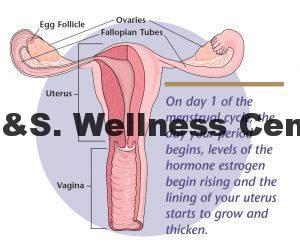 Polycystic Ovary Syndrome (PCOS) arises from a dramatic, ongoing, abnormal shift in a woman’s hormonal balance. This hormone imbalance causes a cascade of negative effects, such as the growth of painful cysts on the ovaries, difficult periods, trouble getting pregnant, diabetes, heart disease, and other health issues.
Polycystic Ovary Syndrome (PCOS) arises from a dramatic, ongoing, abnormal shift in a woman’s hormonal balance. This hormone imbalance causes a cascade of negative effects, such as the growth of painful cysts on the ovaries, difficult periods, trouble getting pregnant, diabetes, heart disease, and other health issues.
Polycystic ovary syndrome (PCOS) is a condition that causes irregular menstrual periods because monthly ovulation is not occurring and levels of androgens (male hormones) in women are elevated. The condition occurs in about 5 to 10 percent of women. The elevated androgen levels can sometimes cause excessive facial hair growth, acne, and/or male-pattern scalp hair thinning. Most, but not all, women with PCOS are overweight or obese, and they are at higher than average risk of developing diabetes and obstructive sleep apnea.
Women with PCOS who want to become pregnant, fertility pills or injections are often needed to help women ovulate. It can cause complication and sometimes serious health problems, and also present some frustrating skincare and hair-growth concerns, including acne, unwanted hair growth, balding, and skin darkening. These are just a few of the worrisome, emotional struggles facing women with PCOS.
What are the causes of polycystic ovary syndrome (PCOS) ?
The cause of polycystic ovary syndrome (PCOS) is not completely understood. It is believed that abnormal levels of the pituitary hormone luteinizing hormone (LH) and high levels of male hormones (androgens) interfere with normal function of the ovaries. To explain how these hormones cause symptoms, it is helpful to understand the normal menstrual cycle.
Normal menstrual cycle — The brain (including the pituitary gland), ovaries, and uterus normally follow a sequence of events once per month; this sequence helps to prepare the body for pregnancy. Two hormones, follicle-stimulating hormone (FSH) and LH, are made by the pituitary gland. Two other hormones, progesterone, and estrogen, are made by the ovaries.
During the first half of the cycle, small increases in FSH stimulate the ovary to develop a follicle that contains an egg (oocyte). The follicle produces rising levels of estrogen, which cause the lining of the uterus to thicken and the pituitary to release a very large amount of LH. This midcycle “surge” of LH causes the egg to be released from the ovary (called ovulation). If the egg is fertilized by a sperm it develops into an embryo which travels through the fallopian tube to the uterus. After ovulation, the ovary produces both estrogen and progesterone, which prepare the uterus for possible embryo implantation and pregnancy.
Menstrual cycle in PCOS — In women with PCOS, multiple small follicles (small cysts 4 to 9 mm in diameter) accumulate in the ovary, hence the term polycystic ovaries. None of these small follicles are capable of growing to a size that would trigger ovulation. As a result, the levels of estrogen, progesterone, LH, and FSH become imbalanced.
Ovaries and the adrenal glands produces Androgens. Examples of androgens include testosterone, androstenedione, dehydroepiandrosterone (DHEA), and DHEA sulfate (DHEA-S). Women with PCOS have increase level of Adrogens because of the high levels of LH, but also because of high levels of insulin that are usually seen with PCOS.
Polycystic ovary syndrome (PCOS) Symptoms:
The changes in hormone levels described above cause the classic symptoms of polycystic ovary syndrome (PCOS), including absent or irregular and infrequent menstrual periods, increased body hair growth or scalp hair loss, acne, and difficulty becoming pregnant. Signs and symptoms of PCOS usually begin around the time of puberty, although some women do not develop symptoms until late adolescence or even into early adulthood. Because hormonal changes vary from one woman to another, patients with PCOS may have mild to severe acne, facial hair growth, or scalp hair loss.
Menstrual irregularity — If ovulation does not occur, the lining of the uterus (called the endometrium) does not uniformly shed and regrow as in a normal menstrual cycle. Instead, the endometrium becomes thicker and may shed irregularly, which can result in heavy and/or prolonged bleeding. Irregular or absent menstrual periods can increase a woman’s risk of endometrial overgrowth (called endometrial hyperplasia) or even endometrial cancer.
“Women with PCOS usually have fewer than six to eight menstrual periods per year. Some women have normal cycles during puberty, which may become irregular if the woman becomes overweight”.
Weight gain and obesity — PCOS are associated with gradual weight gain and obesity in about one-half of women. For some women with PCOS, obesity develops at the time of puberty.
Hair growth and acne — The Male-pattern hair growth (hirsutism) may be seen on the upper lip, chin, neck, sideburn area, chest, upper or lower abdomen, upper arm, and inner thigh. Acne is a skin condition that causes oily skin and blockages in hair follicles.
Insulin abnormalities — PCOS is associated with elevated levels of insulin in the blood. Insulin is a hormone that are produced by specialized cells within the pancreas; it regulates blood glucose levels. When blood glucose levels rise (after eating, for example), these cells produce insulin to help the body use glucose for energy.
- If glucose levels do not respond to normal levels of insulin, the pancreas produces more insulin. Excess production of insulin is called hyperinsulinemia.
- When increased levels of insulin are required to maintain normal glucose levels, a person is said to be insulin resistant.
- When the blood glucose levels are not completely controlled, even with increased amounts of insulin, the person is said to have glucose intolerance (sometimes referred to as “prediabetes”).
- If blood glucose levels continue to rise despite increased insulin levels, the person is said to have type 2 diabetes.
These conditions are diagnosed with blood tests.
Insulin resistance and hyperinsulinemia can occur in both normal-weight and overweight women with PCOS. Among women with PCOS, up to 35 percent of those who are obese develop impaired glucose tolerance (“prediabetes”) by age 40 years, while up to 10 percent of obese women develop type 2 diabetes. The risk of these conditions is much higher in women with PCOS compared with women without PCOS.
A family history of diabetes, overweight and obesity, as well as race and ethnicity (particularly African American and Hispanic) can increase the likelihood of developing diabetes among women with PCOS.
Infertility — Many women with PCOS do not ovulate regularly, and it may take these women longer to become pregnant. Infertility evaluation is often recommended after 6 to 12 months of trying to become pregnant.
Heart disease — Women who are obese and who also have insulin resistance or diabetes might have an increased risk of coronary artery disease, the narrowing of the arteries that supply blood to the heart. It is not known for sure if women with PCOS are at increased risk for this condition.
Both weight loss and treatment of insulin abnormalities can decrease this risk.
Sleep apnea — Sleep apnea is a condition that causes brief spells where breathing stops (apnea) during sleep. Patients with this problem often experience fatigue and daytime sleepiness. In addition, there is evidence that people with untreated sleep apnea have an increased risk of insulin resistance, obesity, diabetes, cardiovascular problems, such as high blood pressure, heart attack, abnormal heart rhythms, or stroke. This risk may be changes in heart rate and blood pressure that occur during sleep.
Sleep apnea may occur in up to 50 percent of women with PCOS. The condition can be diagnosed with a sleep study, and several treatments are available.
I Think I Have PCOS … Now What?
If you suspect you have PCOS, see your physician and discuss your symptoms openly and honestly.
Have you been diagonized of PCOS? Don’t be Scared, solution to treat PCOS without Surgery is available at I A and S Wellness centre.
So, How Can I.A.& S. Wellness Centre Help Me To Solve My Polycystic Ovary Syndrome Problem?
The Best And Working Solution Is:
POLYCYSTIC OVARY SYNDROME SOLUTION KITS
FOR MORE DETAILS ON OUR POLYCYSTIC OVARY SYNDROME TREATMENT
OUR ADDRESS:
3rd Floor, 473, Lagos-Abeokuta Express Way, Old UBA Building Beside NNPC,, U-turn Bus Stop, Abule Egba, Lagos, Nigeria.
Mon – Friday (9.00 a.m. – 5.00 p.m.) Nigerian Time
Saturday (10.00 a.m. – 2.00 p.m.) Nigerian Time
Our Office is Close on Sunday but you can Whatsapp, Call, Email Us.
- WHATSAPP: (+234)-8038690104
- CALL: 08038690104 OR +234-8038690104
- EMAIL: [email protected]
The following are some of the treatments we offer Alphabetically (A-Z);
- Abdominal pain Natural treatment
- Abnormal Vaginal bleeding Natural treatment
- Acquired Immunodeficiency Syndrome(AIDS) natural treatment
- Adhesion natural treatment
- Amenorrhea Natural treatment
- Anemia natural treatment
- Arteriosclerosis and Atherosclerosis Natural treatment
- Appendicitis Natural treatment without surgery
- Asthma Natural treatment
- Candidiasis Natural treatment
- Cancer Natural treatment
- Cervical Polyps Natural treatment
- Cholesterol Natural treatment
- Chlamydia Infection Natural treatment
- Fibroids Natural Treatment (without surgery)
- Female Infertility Natural treatment
- Fibrocystic Breast Natural Treatment
- Gallstones Natural Treatments
- Glaucoma Natural treatment
- Hormonal imbalance Natural treatment
- Hypertension Natural treatment
- Insomnia Natural treatment
- Kidney disease Natural treatment
- Kidney stones Natural treatment
- Male infertility Natural treatment
- Menopause Natural treatment
- Mouth odor and Cancer Natural treatment
- Obesity Natural treatment
- Ovarian Cysts Natural Treatment
- PCOS (polycystic Ovary syndrome)Natural treatment
- Parkinson disease Natural Treatment
- Prostatitis Natural Cure
- Prostate Cancer Natural Treatment
- Polyps Natural Treatment
- Pelvic Inflammatory Disease Natural Treatment
- Toothache Natural Treatment
- Tuberculosis Natural Treatment
- Vericocele Natural Treatment (without surgery)
- Vaginitis Natural Treatment
- Vaginal Infection and Natural treatmentetc

